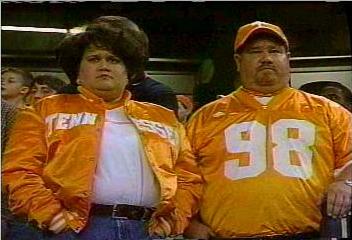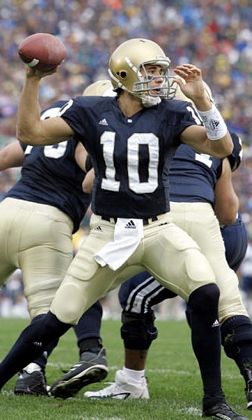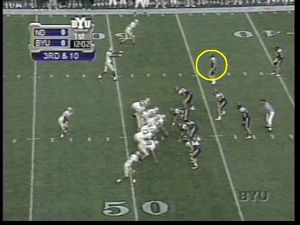From week to week, it often seems like there's a brand-new theme to Charlie's offensive gameplan, tailored specifically to that opponent. Something that's more than just a new wrinkle, but a entirely different approach...something that defines the way we're going to move the ball that day, and when you recognize it, sort of gives you a glimpse into the war room: "Gentlemen, on Saturday, we're going to do
this.
This will be our identity this week."
Against Michigan State, we threw long quite a bit -- something we hadn't seen that much to date. Against Washington, the toss-sweep was run about ten times. For USC, it was the presence of Travis Thomas getting equal billing in the backfield, splitting carries with Darius and giving our running game a brand-new dimension.
And against BYU, the defining theme was
no-huddle, five-wide.
On Saturday, we came out in the no-huddle, five-wide, empty backfield, threw the ball nine times, never once ran it, and drove the length of the field (finally scoring on a pass to Stovall out of a three-wide, 1-RB set). We kept returning to the five-wide for long stretches against BYU, mixing in a few tight ends here and there. As far as I can recall, the only time we've seen that set was for a few drives against Michigan. Against BYU, it defined the offense.
And it worked like a charm. Coach Mendenhall,
after the game:
"There weren't many surprise, but I was a little surprised early by the number of empty formations and quick throws. We never really took that away from them. Either way, they were attacking us through the air and that is where we were the most vulnerable and that is where they were most successful today."
One thing about putting five wide receivers and no running backs on the field: you can't run the ball very much. After last year's dismal rushing output, I'm sure many of us thought we'd rectify that deficiency this year. Even the team considered last year's rushing attack
woefully inadequate. Before the game:
"Everybody knows that we had 11 yards rushing last game. That's just unacceptable," offensive tackle Ryan Harris said. "That's nowhere near where we want to be as an offensive line. We've come a long way."
Talk about sandbagging. When the game was over, we had 23 rushes on the day, but a few of those were sacks or QB hurries, and eleven of those carries came during the fourth quarter while holding at least a 19-point lead. As a matter of fact, we had only two actual running plays (not including sacks and sideline laterals) in the entire first half of the game, if you can believe that. From the
Fort Wayne Journal-Gazette:
A year after the embarrassment of being held to a mere 11 yards rushing - their worst rushing game in 39 years - the No. 9-ranked Fighting Irish didn't even try to run the ball in a 49-23 victory over Brigham Young until they were trying to run out the clock.
With BYU blitzing and stunting, Irish coach Charlie Weis was only too happy to keep passing. He talked after the game how he was amused at halftime when he was asked by an NBC sideline reporter if the Irish planned to run the ball in the second half, and replied: "Not if they keep blitzing."
"They look at me as if I'm stupid," Weis said. "I'm looking at them like they're stupid, too. I don't know who's right and who's wrong, but football doesn't have to be as complicated as people make it out to be sometimes."
Weis made it look simple on Saturday, putting the ball in the hands of Brady Quinn, who threw for 467 yards and a school-record six touchdowns. In the first half, the Irish ran the ball eight times for a total of 1-yard lost, while Quinn set a school record for passing yards in a half with 287.
"Obviously we didn't run the ball very many times," Weis said. "The risk you take when you do that is if your quarterback has a bad day, you lose. That's a calculated risk you have to take. But I have no problem putting the ball in his hands."
Weis tipped his hand in the opening drive, going with an empty backfield most of the drive. He didn't put tailback Darius Walker into the game until on third-and-6 from the BYU 10, and then he was in as a blocker when Quinn threw a TD pass to Maurice Stovall, who had four TD catches.
"When you see a mismatch with any team, you want to throw it there and that's what we did this game," Stovall said. "We knew in order to be productive we had to be productive in the passing game."
That's what makes Notre Dame (5-2) so difficult to prepare for this season. They depend on the run in some games, like in the opening game victory against Pittsburgh, go more balanced in some games, like the victory against Michigan, or depend on the pass, like the victory over Purdue.
So, the BYU
box score says we hardly ran at all on Saturday. Or did we?
COACH WEIS: Overall I'm not as upset when you look at the stats and say, well, you rushed for 1.9 per carry, but all those look passes and swing passes that we threw out there when they're bringing the house, and we throw those balls to those receivers at the line of scrimmage, to me they're like outside runs. You'd be adding another couple hundred yards to your running game. If anyone took a couple hundred yards added to the running game, I don't think anyone would be complaining too much about the yardage there.

Now, maybe that's stretching the definition of
run a bit. After all, it's not like a long handoff, or a pitch -- it's actually a pass that gets the play started.
However, it
is a remarkably high-percentage pass, and when you've got a strong-armed QB like Quinn slinging it, the ball gets out there in a hurry. Whatever you call it, it's better than running up the middle against a 7- or 8-man front. Why try and pound it, when a short cornerback is single-covering Stovall, and all you have to do is chuck it out to him and let him ramble in for a touchdown from 24 yards out?
(Or, alternately, pump-fake the quick sideliner and throw it over the top for an easy score. "Wasn't that a thing of beauty?"
said Charlie. Yes. Yes it was.)
Interestingly, running the ball was sometimes actually part of the original play-call from the sidelines; BQ oftentimes has a run-pass option on the play. Charlie explains:
"There were a lot of runs in there that were run-pass checks, and the quarterback was close to flawless on his decision-making. When you bring that many guys on every play, obviously, the quarterback and the receivers have to make some plays, but you leave yourself very vulnerable. I was kind of hoping that was the way it was going to go."
"Q: Is [Quinn] actually checking off a run to a pass?"
"It's built-in in the play. When I call a play it's a play where he doesn't have to say anything -- we're set and ready to go."
This is similar to what was employed against Purdue -- that quick pass as a second-option on what might have been a running play. Charlie
commented after Purdue that there were a few more runs on the call sheet that ended up being passes:
''Brady played exceptional [against Purdue],'' Weis said. ''He checked off runs into passes and just picked 'em apart. He's playing liked the leader I expected him to be.''
So, you must remember this...a pass is just a pass. Except when it isn't.

Anyway, how did all that passing -- I mean running -- break down into positive yardage against BYU?
• We had 467 yards passing in the game.
• By my count, we had 177 yards after the catch. (I don't know how this compares to other games; unfortunately UND.com doesn't keep track of YAC). That's 38% YAC.
• About 133 yards of the YAC were from passes complete around the line of scrimmage: zero-yard passes that were almost all YAC. Specifically:
Five sideline passes to Stovall for 55 yards
Four sideline passes to Samardzija for 36 yards
One screen to Darius for 37 yards
One screen to Fasano for 5 yards
• In addition, we also had a couple of
pass interference calls that would have boosted our offensive stats even further.
To put it succinctly, we were Yac-tacular.
Finally, a postscript on
last year's BYU game and some interesting statistical oddities.
• Time of possession was almost exactly equal this year compared to last year (26:28 to 26:21, a seven-second difference).
• We threw more passes last year, believe it or not (47 to 45).
• We had almost the exact same rushing yardage (if you discount the garbage time rushes in this year's game).
• We actually won the turnover battle last year (+1). This year we broke even.
So, to recap: same time of posession, same passing attempts, same rushing yardage, worse turnover ratio. That translates to...
2004: Three-point loss.
2005: Twenty-six point blowout.
What a difference a year makes.


 Just a great article by Jeff Carroll in yesterday's South Bend Tribune that covers the one year Coach Weis spent as the head coach of Franklin Township High School in New Jersey before he took the job with the New York Giants. There have been untold numbers of background stories and puff pieces done on Coach Weis already, but this story really does a great job of highlighting a stop on Charlie's resume that's been mostly overlooked.
Just a great article by Jeff Carroll in yesterday's South Bend Tribune that covers the one year Coach Weis spent as the head coach of Franklin Township High School in New Jersey before he took the job with the New York Giants. There have been untold numbers of background stories and puff pieces done on Coach Weis already, but this story really does a great job of highlighting a stop on Charlie's resume that's been mostly overlooked. BC athletic director Gene DeFilippo would not comment directly on Notre Dame's decision to discontinue its football relationship with BC. The Eagles and Irish were originally scheduled to play through 2013, but Notre Dame informed DeFilippo in the spring it only wanted to go until 2010. The Eagles have beaten Notre Dame three consecutive seasons, including two meetings in South Bend.
BC athletic director Gene DeFilippo would not comment directly on Notre Dame's decision to discontinue its football relationship with BC. The Eagles and Irish were originally scheduled to play through 2013, but Notre Dame informed DeFilippo in the spring it only wanted to go until 2010. The Eagles have beaten Notre Dame three consecutive seasons, including two meetings in South Bend. For most non-Māori New Zealanders today their knowledge of Haka is perhaps limited to that most performed of Haka called "
For most non-Māori New Zealanders today their knowledge of Haka is perhaps limited to that most performed of Haka called "
 Now, maybe that's stretching the definition of
Now, maybe that's stretching the definition of  Anyway, how did all that passing -- I mean running -- break down into positive yardage against BYU?
Anyway, how did all that passing -- I mean running -- break down into positive yardage against BYU? The new workout plan. Maurice Stovall arrived at Notre Dame with the highest of accolades. He was a first-team USA Today All-American and played in the U.S. Army All American Bowl as a 16-year-old high school senior. Within a few months of his arrival at Notre Dame, he appeared on
The new workout plan. Maurice Stovall arrived at Notre Dame with the highest of accolades. He was a first-team USA Today All-American and played in the U.S. Army All American Bowl as a 16-year-old high school senior. Within a few months of his arrival at Notre Dame, he appeared on 


 Along with this new pro-tradition campaign in and around the Stadium and photos like this one of ND's National Championship rings that recently popped up on und.com, I do enjoy the fact that Notre Dame is being more outgoing about the proud history of the football program.
Along with this new pro-tradition campaign in and around the Stadium and photos like this one of ND's National Championship rings that recently popped up on und.com, I do enjoy the fact that Notre Dame is being more outgoing about the proud history of the football program. Last there are our comments in our
Last there are our comments in our  The Air Raid typically features multiple receivers flooding zones and a quarterback who can make quick progression reads. In other words, airing it out -- a lot. Texas Tech, for example, throws the ball 50+ times per game, rain or shine.
The Air Raid typically features multiple receivers flooding zones and a quarterback who can make quick progression reads. In other words, airing it out -- a lot. Texas Tech, for example, throws the ball 50+ times per game, rain or shine.



